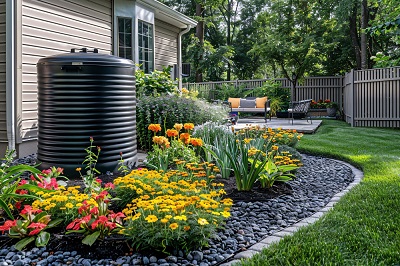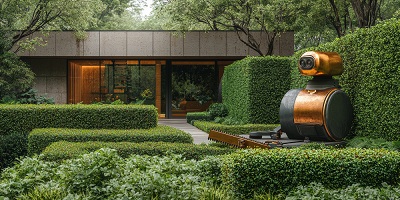Transforming your outdoor space into a stunning and functional landscape is a rewarding endeavor that not only enhances the aesthetic appeal of your property but also adds value to your home. Whether you’re planning a complete overhaul or a simple upgrade, understanding the essentials of landscaping is crucial. This guide will take you through the key steps and considerations to ensure that your outdoor space becomes a true extension of your home, offering both beauty and utility.
Understanding Your Landscape: Assessing Your Outdoor Space
Before diving into the design phase, it is essential to assess your existing outdoor space. This involves understanding the unique characteristics of your property, including its size, shape, and existing features. Start by observing the natural elements such as sunlight exposure, soil type, and drainage patterns. These factors will significantly influence the types of plants and materials that will thrive in your landscape.
Sunlight and Shade Considerations
The amount of sunlight your garden receives throughout the day will determine the selection of plants. Full sun areas are ideal for sun-loving plants like roses, lavender, and ornamental grasses, while shaded areas might be better suited for ferns, hostas, and other shade-tolerant species. Mapping out these zones will help in planning the layout effectively.
Soil Quality and Preparation
Soil is the foundation of any successful landscape. Conduct a soil test to determine its pH level and nutrient content. Depending on the results, you may need to amend the soil with compost, mulch, or other organic materials to create an environment where plants can flourish. Soil preparation is a critical step that ensures your plants have the best possible start.
Designing Your Landscape: Creating a Cohesive Plan
Once you have assessed your outdoor space, the next step is to develop a comprehensive landscape design. A well-thought-out design considers the aesthetics, functionality, and sustainability of your space. Start by sketching a basic layout, including all existing and planned elements.
Defining Your Vision
Every successful landscape begins with a clear vision. Decide on the overall theme and style you wish to achieve. Whether it’s a modern minimalist garden, a lush tropical oasis, or a rustic cottage garden, the design should reflect your personal taste and complement the architecture of your home. Consider how each element, from plants to hardscaping, will work together to create a harmonious outdoor environment.
Incorporating Functional Areas
A well-designed landscape balances beauty with functionality. Identify the different zones within your outdoor space, such as entertaining areas, children’s play zones, and vegetable gardens. Each area should serve a specific purpose while contributing to the overall design. Use pathways, borders, and hedges to define these spaces and create a natural flow.
Selecting the Right Plants
Plant selection is one of the most critical aspects of landscape design. Choose plants that are well-suited to your climate, soil, and sunlight conditions. Incorporate a mix of trees, shrubs, perennials, and annuals to create a landscape that is visually interesting and offers year-round appeal. Consider the growth habits and mature size of plants to ensure they won’t outgrow their space over time.
Hardscaping: Building the Backbone of Your Landscape
Hardscaping elements such as patios, walkways, retaining walls, and water features provide structure and definition to your landscape. These features are not only functional but also contribute to the overall aesthetic of your outdoor space.
Choosing the Right Materials
The choice of materials for your hardscaping should complement the style of your home and the natural surroundings. Stone, brick, concrete, and wood are popular choices, each offering different textures, colors, and durability. For a cohesive look, consider using materials that are consistent throughout the landscape, or mix and match to create contrast and interest.
Creating Pathways and Walkways
Pathways and walkways guide movement through your landscape and connect different areas. When designing pathways, think about both form and function. Curved paths can create a sense of mystery and exploration, while straight paths offer a more formal and direct route. Ensure that pathways are wide enough for comfortable passage and are constructed from durable materials that can withstand foot traffic and weather conditions.
Adding Water Features
Water features such as ponds, fountains, and waterfalls add a sense of tranquility to your landscape. The sound of running water can be soothing and helps to mask unwanted noise from nearby streets or neighbors. When incorporating a water feature, consider the scale of your space and the maintenance required. A small fountain may be perfect for a compact garden, while a larger pond or waterfall can become a focal point in a more extensive landscape.
Sustainable Landscaping: Eco-Friendly Practices
Sustainable landscaping involves designing and maintaining your outdoor space in a way that is environmentally responsible and resource-efficient. This approach not only benefits the environment but also reduces maintenance time and costs.
Xeriscaping: Water-Wise Gardening
Xeriscaping is a landscaping method that reduces or eliminates the need for irrigation. By selecting drought-tolerant plants, using mulch to retain moisture, and designing the landscape to minimize water runoff, you can create a beautiful garden that conserves water. This is particularly important in regions prone to drought or where water resources are limited.
Composting and Soil Health
Maintaining healthy soil is essential for a thriving landscape. Composting is an excellent way to recycle organic waste from your garden and kitchen, creating nutrient-rich compost that can be added to your soil. Healthy soil improves plant growth, reduces the need for chemical fertilizers, and helps retain moisture.
Native Plant Landscaping
Using native plants in your landscape design has numerous benefits. Native plants are well-adapted to the local climate and soil conditions, making them more resistant to pests and diseases. They also require less water and maintenance than non-native species. Additionally, native plants support local wildlife, providing food and habitat for birds, insects, and other animals.
Lighting Your Landscape: Enhancing Nighttime Appeal
Landscape lighting is an essential element that adds both beauty and security to your outdoor space. A well-lit garden can be enjoyed at any time of day and provides a welcoming ambiance for evening gatherings.
Types of Landscape Lighting
There are several types of landscape lighting to consider, each serving a different purpose. Path lights illuminate walkways and driveways, making them safer to navigate at night. Spotlights and floodlights highlight specific features such as trees, statues, or architectural details. String lights and lanterns add a decorative touch to patios and pergolas, creating a warm and inviting atmosphere.
Energy-Efficient Lighting Solutions
To minimize energy consumption, consider using LED lights or solar-powered fixtures in your landscape. These options are both eco-friendly and cost-effective, providing long-lasting illumination without the need for frequent bulb replacements. Solar lights are particularly advantageous as they require no wiring and harness energy from the sun, making them easy to install and maintain.
Maintaining Your Landscape: Keeping It Beautiful Year-Round
A beautiful landscape requires regular maintenance to keep it looking its best. Proper care ensures that your plants remain healthy, your hardscaping stays in good condition, and your outdoor space continues to thrive.
Seasonal Maintenance Tasks
Different seasons bring different maintenance needs. In the spring, focus on pruning, planting new plants, and applying mulch to garden beds. Summer maintenance includes watering, weeding, and deadheading flowers. In the fall, prepare your garden for winter by clearing leaves, cutting back perennials, and protecting sensitive plants. Winter is a time to rest, but it’s also an opportunity to plan for the next growing season.
Irrigation and Water Management
Efficient irrigation is key to maintaining a healthy landscape. Consider installing an automated irrigation system with rain sensors to ensure your plants receive the right amount of water without waste. Drip irrigation systems are particularly effective as they deliver water directly to the roots, reducing evaporation and runoff.
Pest and Disease Control
Keeping pests and diseases in check is essential for a healthy garden. Integrated Pest Management (IPM) is a sustainable approach that combines biological, cultural, and mechanical methods to control pests with minimal use of chemicals. Regularly inspect your plants for signs of pests or disease, and take action early to prevent infestations from spreading.
Conclusion
By following these landscaping essentials, you can transform your outdoor space into a beautiful, functional, and sustainable environment that enhances your home’s value and your quality of life. Whether you’re a seasoned gardener or a novice, this guide provides the foundation you need to create a landscape that will be enjoyed for years to come.





